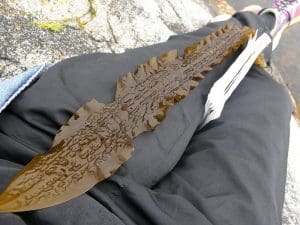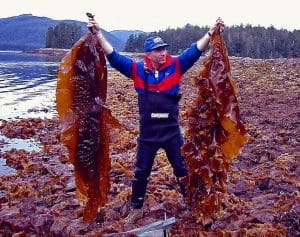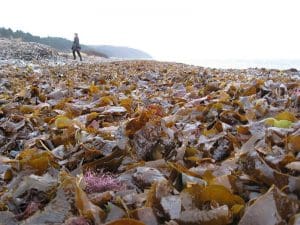Sugar Kelp / Spring / Summer / Autumn / Winter / Edible
Other Common Names:
Sea-belt, Sugar Wrack
Latin Name:
Laminaria saccharina, Saccharina latissima
Harvest Season:
This seaweed grows rapidly from winter until April, so can be a good find when other species have receded.
Habitat:
This seaweed is fond of low water, sheltered areas with fast-moving flows. It dislikes exposed shores, and is often found in patches along water’s edges.
Range and Distributions:
Found throughout the UK, some western coasts of northern Europe, and eastern North America.
Conservation Considerations:
Never pull the entire plant away from its rock – if harvesting from fixed plants, only harvest the frond, leaving the base to reproduce the following year.
Physical Characteristics:
This kelp has a relatively small short, fine stipe (stem), which has a round cross-section and is more flexible than other kelps. Its brown fronds are undivided, with rigidly frilled edges and bubbles/highly textured centre sections. The shape of the fronds can be quite variable depending on the conditions in which the plant grows, e.g. water flow, exposure etc.


Could be Confused with, and Other Safety Notes:
No other species is as rigidly frilled at its edges – dabberlocks is a bit wrinkled and is also brown, but has a distinctive midrib which differentiates it from sugar kelp. As with all seaweeds, a very high iodine content means that those with thyroid issues or taking thyroid medication should take great care if increasing their seaweed intake, letting their healthcare provider know.
Edible Uses:
This seaweed has a uniquely sweet taste, and can therefore be used by the creative cook in many exciting ways.
Marinade and cook down for a new take on sweet and sour sauces, add to exciting salads alongside fruits, cheese and nuts, or experiment with bringing the umami flavours into deserts.
Medicinal Uses:
As with all seaweeds, sugar kelp is very high in minerals and salts due to needing to retain enough water in a very saline environment.
This makes it a wonderful tonic food, important in the maintenance of a thriving nervous, immune and just about every other body system.
Consume in moderation – see the safety section above. Clinically (by medical herbalists), seaweeds are often used for skin and skeletal issues.
Extra Points, Tips and Fun Facts:
The sugar in the name refers to a white, sweet powder (mannitol) that forms on the dried fronds of this species. On the Orkney Island of North Ronaldsay, sugar kelp is enthusiastically enjoyed by a certain breed of sheep, for whom seaweed is one of the only available foods for some parts of the year.







Leave a Reply
You must be logged in to post a comment.